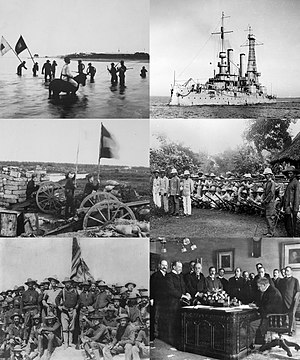Spanish–American War
1898 conflict between Spain and the United States From Wikipedia, the free encyclopedia
The Spanish–American War was a war fought between Spain and the United States in 1898, partly because many people in Cuba, one of the last parts of the Spanish Empire, wanted to become independent. Many Americans also wanted their country to get a colonial empire.
| Spanish–American War[a] | |||||||||
|---|---|---|---|---|---|---|---|---|---|
| Part of the Philippine Revolution and the Cuban War of Independence | |||||||||
 (clockwise from top left)
| |||||||||
| |||||||||
| Belligerents | |||||||||
|
United States Cuban revolutionaries[c] First Philippine Republic
|
| ||||||||
| Commanders and leaders | |||||||||
|
Other leaders
Other leaders
Other leaders
|
Other leaders
| ||||||||
| Strength | |||||||||
|
Total: 300,000[1] |
Total: 339,783[4]
| ||||||||
| Casualties and losses | |||||||||
|
American: |
Spanish: | ||||||||
|
The higher naval losses may be attributed to the disastrous naval defeats inflicted on the Spanish at Manila Bay and Santiago de Cuba.[9] | |||||||||
Spain lost the sea war and so had to give up Cuba, the Philippines, Puerto Rico, and Guam. All of those colonies, except for Cuba, became American colonies after the war, and Cuba became an independent country but with much US influence.
Background
Following reports of Spain abusing and killing Cubans, the United States sent warships to Cuba. Spain was losing control of Cuba and so put Cubans into concentration camps. The US sent ships to Cuba to try to make Spain to give up Cuba. The USS Maine exploded in Havana Harbor, which killed about 260 people on board.
"Remember the Maine" became a common wartime saying. US newspapers blamed Spain for the explosion without proof. Spain tried to avoid going to war, but pressure from US newspapers, which had "yellow journalism," and from ordinary people persuaded the US government to go to war. Some Americans wanted Cuba to become independent, but others hoped that the US could build a colonial empire overseas since many European countries had already done so.
Course of war
Volunteers throughout the country signed up for the war. Future US President Theodore Roosevelt raised troops and became famous by leading the Rough Riders during the Battle of San Juan Hill.
In a large naval battle in Manila Bay, an American fleet, commanded by George Dewey, destroyed the Spanish fleet.
Ground battles took place in Cuba and Puerto Rico.
Aftermath
The US won the war and soon began to occupy and to take control of the colonies after Spain had surrendered. Almost 400 American soldiers had died during the fighting, but more than 4000 Americans died from diseases such as yellow fever, typhoid, and malaria.
The Treaty of Paris was signed on December 10, 1898 by the United States and Spain. The United States now controlled Puerto Rico, Guam, and the Philippines.[12] Later, it also got the Guantanamo Bay Naval Base, and Cuba became an independent country but with much US influence.
Notes
- Alternative names:
- Lua error in package.lua at line 80: module 'Module:Lang/configuration' not found. or Lua error in package.lua at line 80: module 'Module:Lang/configuration' not found.
- Lua error in package.lua at line 80: module 'Module:Lang/configuration' not found..
- American English:
- The War of 1898'"`UNIQ--ref-00000003-QINU`"''"`UNIQ--ref-00000004-QINU`"''"`UNIQ--ref-00000005-QINU`"'
- Uncle Sam's War of 1898'"`UNIQ--ref-00000006-QINU`"'
References
Sources
Wikiwand - on
Seamless Wikipedia browsing. On steroids.
